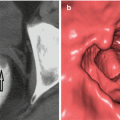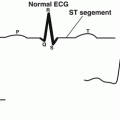© Springer International Publishing Switzerland 2015
Omer Engin (ed.)Colon Polyps and the Prevention of Colorectal Cancer10.1007/978-3-319-17993-3_44. Pre-operative Pulmonary System Evaluation
(1)
Pulmonology Department, Buca Seyfi Demirsoy State Hospital, Izmir, Turkey
(2)
Emergency Department, Bozyaka Training and Research Hospital, Izmir, Turkey
Colonoscopy is an interventional procedure that could be performed under sedoanalgesia and usually completed without complications. Laparotomy under general anaesthesia might be necessary for rarely seen complications like intestinal perforation or spleen rupture. Also during colonoscopy, pulmonary functions may worsen as a result of increased intraabdominal pressure due to air insufflation. In our opinion, pre-procedural evaluation by a pulmonary specialist is necessary in patients with pulmonary disease. In this chapter, pre-procedural pulmonary system evaluation for both colonoscopy and laparotomy is mentioned.
The purpose of pre-operative evaluation is to determine complication and mortality risk and to plan post-operative follow-up. Pulmonary complications arise due to volume changes that depend on changes in lung wall mechanics and respiratory muscle dysfunction and prolong hospitalization and increase morbidity and mortality following surgery. Obesity, general anaesthesia, supine position, ascites, advanced age, smoking, volume load, pulmonary edema, bronchospasm and excessive secretion in airways increase post-operative pulmonary risk. Types of surgery, anaesthesia and pharmacological agent used also affect post-operative risk. COPD (Chronic Obstructive pulmonary Disease) patients have three to fivefold increase in post-operative pulmonary complications [1]. There is no clinical data in terms of post-operative risk in patients with stable asthma, restrictive lung disease and vascular lung diseases. In case of an asthma attack, operation should be postponed and attack should be treated first.
The more distant a surgical procedure is performed to the chest wall, the more decrease in pulmonary complication rate is seen. Vital capacity (VC) and functional residual capacity (FRC) might decrease after surgery [2–5]. Decrease in FRC is the most important parameter for the development of pulmonary complications [6]. FRC and VC may decrease when intraabdominal pressure increases as the bowel is insufflated with air and complications such as pneumonia and respiratory failure may develop due to decreased regional ventilation and atelectasis [6, 7].
During post-operative period, diaphragm dysfunction (trauma during surgery, inhibitory reflexes due to vagal and splanchnic receptor stimulation), gas exchange disorders (ventilation-perfusion mismatch), respiratory depression (due to anaesthesia) and diminished cough and mucociliary clearance activity increase pulmonary infection risk [8].
Pre-operative Evaluation
Clinical Evaluation
Evaluation of the patient should include family history of pulmonary disease, profession, smoking history, previous bronchodilator use, functional capacity, presence of dyspnoea, cough, sputum and previous lower respiratory system infection history. Pulmonary auscultation findings are important especially if pathological findings are present.
Chest X-Ray
Chest X-ray evaluation has no additional benefit in patients without risk factors and pathological physical examination but is valuable when post-operative complications occur in order to compare pre- and post-operative findings.
Stay updated, free articles. Join our Telegram channel

Full access? Get Clinical Tree





